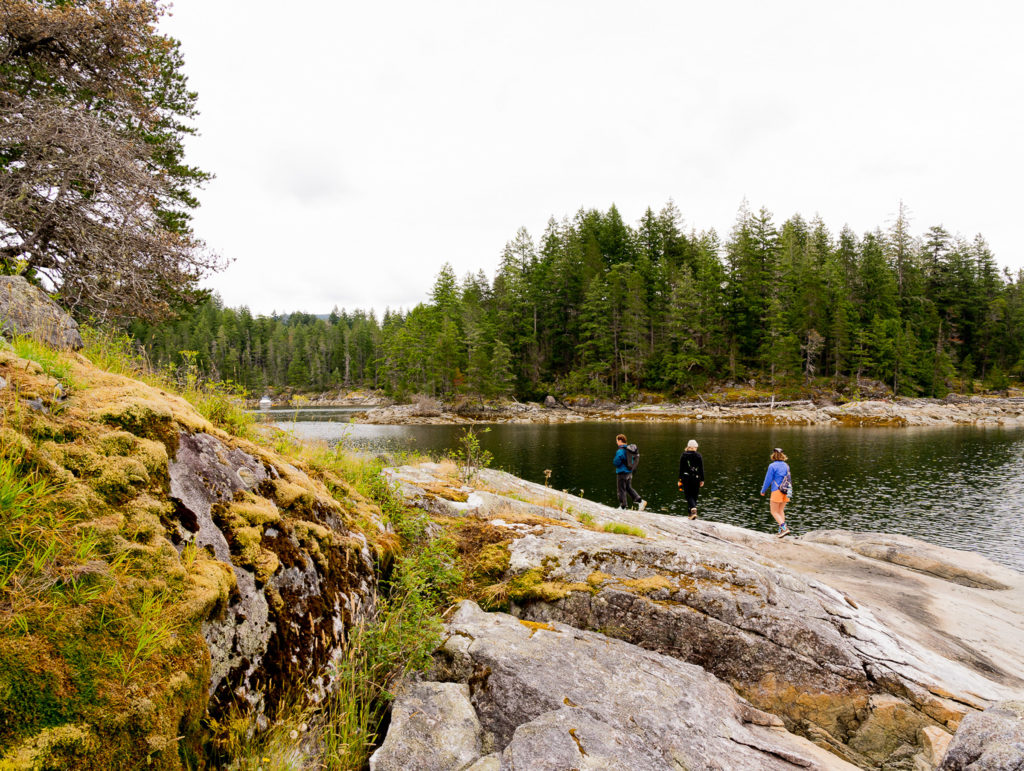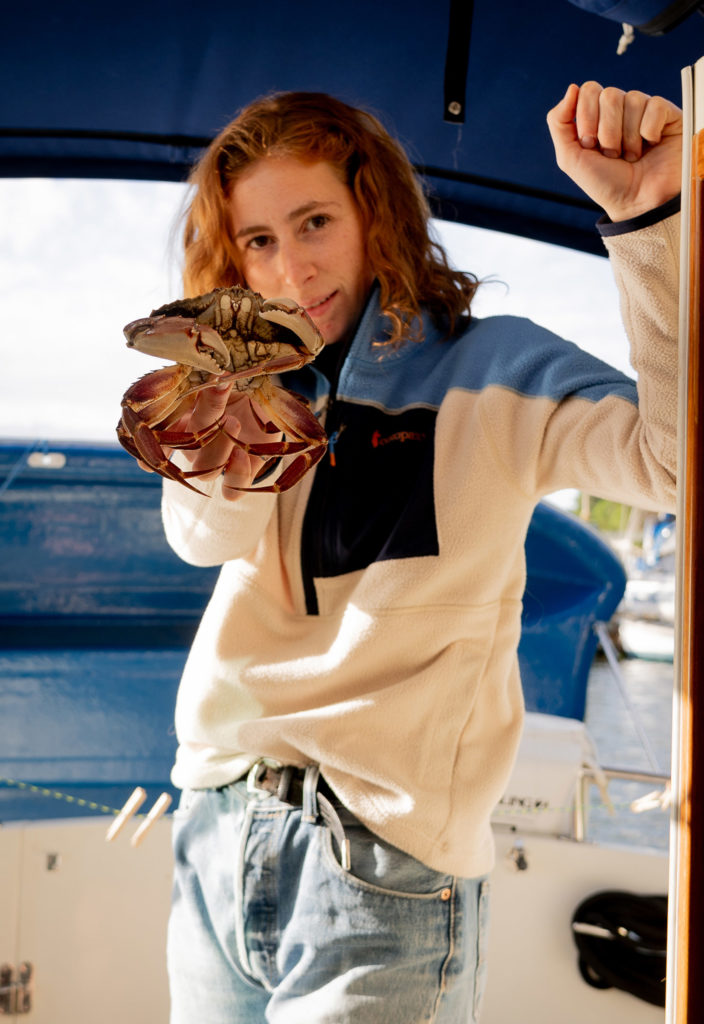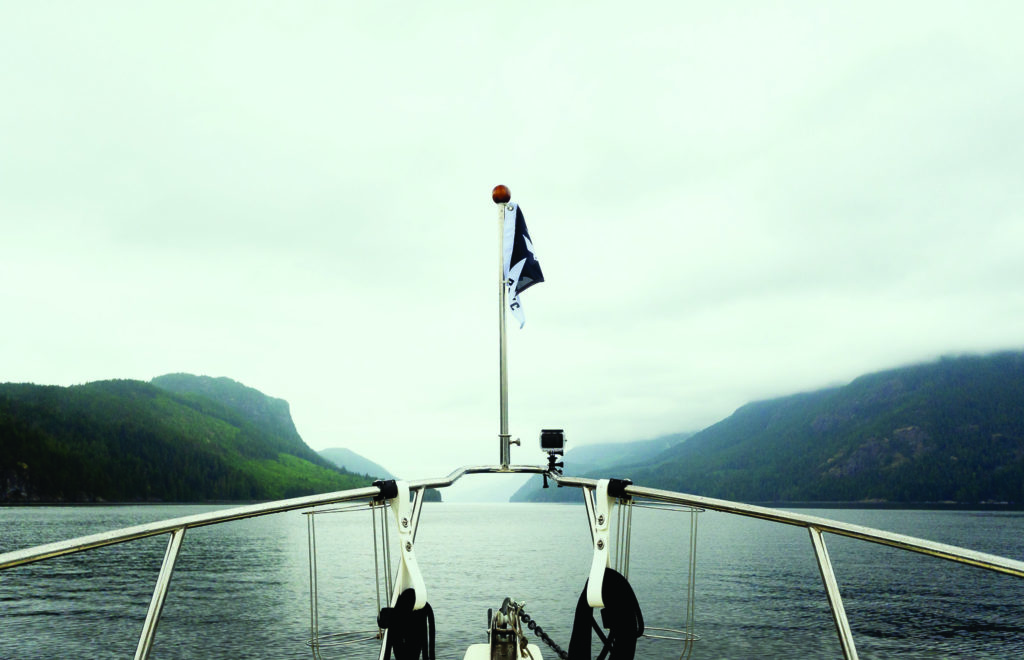
By Nia Martin
Two weeks into a two-month trip along Canada’s Inside Passage, the fleming, which keeps the rode of the anchor from getting stuck in the pulley, snapped. The 20-something, four-woman crew on By All Means, a North Pacific 28 pilothouse trawler, were literally in a tight spot.
“Behind us, there’s this falling down dock that just looks like a safety hazard. And then, on the other side, there’s a reef, and on the other side, there’s a cliffside,” says Uhane Johnson, who served as navigator aboard By All Means, when describing the calamitous moment. “We were working together, trying to communicate to not hit anything, while also pulling up a 30-pound anchor, plus 50 feet of chain.” Ultimately, elbow grease, teamwork, and a milk crate loaned by friends saved the journey—which spanned from Washington’s San Juan Islands to Stuart Island in British Columbia.
The inspiration for that journey—author Muriel Wylie Blanchet—would have been proud. Blanchet, known as Capi (short for Captain), encountered many a tight spot in the Inside Passage and wrote about her adventures in The Curve of Time. The book is a firsthand account of her trips through British Columbia’s waters as a young widow with five children and her dog in tow. Almost 100 years later, Blanchet’s vivid descriptions, fearless independence, and colorful characters still inspire a sense of adventure.
It motivated Annie Means to organize her three friends this summer and take to the same waters that Capi sailed in the 25-foot Caprice. Means dreamed about such experiences since her family gifted her the Northwest literary classic at age 14. Originally from West Seattle, she skippered By All Means, which they had access to courtesy of her parents. “We’re very fortunate that they had the lack of common sense to let their kid and three other women use it,” she jokes.
“There was something about her; her spirit and her willingness to go against the flow of things I thought was really compelling,” says Means of why she wanted to follow in Capi’s wake. “Since we’ve done the trip, I think we are even more inspired, because we learned this is way harder than we thought it was,” she adds. “She was doing all of this with Captain Vancouver’s logbook, charts, and a compass; and we’re out here with a GPS being like, ‘Hmm, are we in the right spot?’”
The women all met and went to school in Walla Walla, Washington, where Means is currently finishing her last year at Whitman. The rest of the By All Means crew have since left the landlocked eastern Washington town. Johnson, a Lopez Island native, is now working for an organic body products company in Bellingham. Erin Beaudoin, the boat’s human stern thruster hailing from Southern Oregon, now resides in Los Angeles doing business development for space tech startups. Emery Hansell grew up in the Midwest and currently traveling for her freelance videography. She helped hand pull the anchor and oversaw filming that will hopefully become a documentary.
Prior to their June 8th launch from the San Juans, each member acquired their boating license and, between the four, had some EMS experience and Wilderness First Responder certification. Much like Capi’s excursions, the journey was low budget. The women squished themselves and their few belongings into the boat; jamming jackets, Chacos, and denim (all of which became cutoffs) inside designated drawers. The four made do with a 40-gallon water tank, but sometimes spent days cut off from resources, which meant a lot of dips and dishwashing in the ocean. When available, shower prices ranged from 10 loonies (about $10) for a five-minute shower to two loonies for unlimited time. “We’d try to take showers when we found those places. Someone would run up the dock and be like, ‘You guys, deal of the century!’” says Beaudoin.
One intention of the trip was to observe the environmental changes between Capi’s sailings and the crew’s experience in 2022. A major difference? The amount of people. “We were never alone. We had a big conversation: ‘Is it even possible to find somewhere that we won’t see anyone for a couple of days?’” says Johnson. “Emery (Hansell) was looking at charts, trying to figure out where that might be. We just decided that it’s not possible anymore, unless we went farther north, because it’s such a trafficked area.”

Another difference was fishing access. “There’s a lot of fishing regulations in place, because the area’s been so overfished by commercial vessels that, now to preserve species, the season is closed for a lot of the year,” says Beaudoin. Bivalve harvesting was also off the table with biohazard warnings due to untreated waste and harmful algal blooms proliferating as waters continue to get warmer. This required the group to rely more on groceries and paying to dispose of waste properly. To help lessen their footprint, they used sustainable body products, worked with less water, and utilized a solar panel.
A similarity to Capi’s trips that took the crew by surprise was the impact of logging. Now logged twice, the forested landscapes lining their journey have gone from a 100-year rotation to a 70-year rotation. Capi wrote about the logging cycle on her journeys and often tied up to log booms. Today, even amongst the stunning topography, the group could see helicopters removing logs by hook and dropping them into a net.
However, one spot from Blanchet’s book that particularly exceeded expectations was Princess Louisa Inlet. “It is awe inspiring,” describes Means, “cavernous walls that have waterfalls cascading from them—and you open up into, what appears like it could be a lake, but it’s all saltwater. It felt like Yosemite—the waterfront version. And it blew my mind completely away.”
Despite wondrous surroundings, the crew was conscious of a darker aspect of Capi’s journeys: the treatment of Indigenous communities. “It’s no secret that when you reread The Curve of Time, Muriel Wylie Blanchet was interested in Indigenous cultures, but not necessarily respectful of them,” says Means. “So that’s something that we’re trying to deal with and wrestle with; how do we still respect a woman who we look up to, but also understand that she was not perfect, and that we need to address some of the wrongdoings that she participated in?”
Looking at women in boating then versus now also revealed what has changed—or still needs to. Unlike today, Capi was put in the position of having to choose between autonomy or financial security after the death of her husband. Though the crew’s choices are much less limited, they noticed how few women are still represented in outdoor boating and, if present, were usually with a man as part of a couple.
Though most were pleasantly surprised by the group of four women and their travels, reactions from both men and women sometimes veered into sexist territory. “The two questions that we were consistently asked were: ‘Is it just you four on the boat?’ Implying, you know, ‘Where’s your captain? Where’s the man? Where’s the older person?’ And, ‘How are you girls all still friends after living on a boat together?’ Implying that women are catty and can’t cohabitate,” says Means.
But cohabitating was smooth sailing, with the group connecting over silly fun and sudden crises alike. Besides the anchor debacle, the crewmembers also rallied together during predicaments such as stormy conditions, a dead battery, the disappearance of their drone for 20 minutes, and bloody gashes from those pesky, razor-like oyster shells—all of which reached satisfactory ends due to the four’s easy camaraderie.
In less dramatic moments, the crew passed time by knitting, listening to podcasts, and reading—with books often found at Little Free Libraries. A particular favorite read aloud was Deadman Island by D.W. Ulsterman, the seventh book in the San Juan Islands Mystery franchise. “It’s about a murderous sea lion and a lot of in-island politics,” laughs Beaudoin. “That was a great way to bond.”
Additionally, the crew kept busy shooting footage for their documentary, which they hope to have a rough cut of out next summer.
For now, the four are adjusting back into their everyday land lives and the rapid demands of modern life. “Trying to hold on to a little bit of that slow living and relaxation from the boat has been a little tough to reconcile,” says Hansell. That sentiment was shared by the whole group.
Upon reflection, a lasting impact of the trip were the people met along the way, from a chance encounter with boat designer Chris Morejohn to befriending worldly retired couples and affable liveaboards. “It was inspiring to have [support] not just from our peers, but also from people that have had a life that has been lived in an unusual way and done so with grace,” says Hansell. “That gave, at least me and I think everybody else, a lot of hope for being able to do the same ourselves.”
Towards the end of their journey, the crew found themselves reunited in Pender Harbour with people they’d met along their route. “It was a really nice way to wrap up—share fresh prawns and salmon and veggies, and just have a little dock party with a community we had built in just two months,” says Beaudoin. “That made us all think about how great it would be to go back and do it again.”
>> To keep up-to-date on production details of the forthcoming documentary, or to relive the women’s journey via their social handles, visit: linktr.ee/capithemovie.



